|
|
|
 |

 |
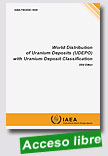 |
World Distribution of Uranium Deposits (UDEPO), with Uranium Deposit Classification, 2009 Edition
IAEA TECDOC Series, 2009, 126 p.
Having comprehensive information on the worldwide uranium deposits is crucial for implementation of significant nuclear power programmes in the world, especially with the increasing interest in nuclear power and concerns about the supply of energy resources. Starting from the early years of the development of nuclear energy for peaceful uses, the International Atomic Energy Agency has published numerous reports on different types of uranium deposits, their geological |
characteristics and geographical distribution. With the increased amount of information available on uranium deposits throughout the world, the IAEA was able to establish an electronic database and publish it in the form of an Atlas in 1995. The atlas later was supported with a World Guidebook to Accompany IAEA Map: World Distribution of Uranium Deposits, in the form of a databook in 1996. The name of the database was World Distribution of Uranium Deposits (UDEPO).
The UDEPO database was revised and expanded in 2004 to store to provide more detailed information on uranium geology and technical characteristics of the deposits. The revised database has been published on the internet since 2004. The database and its web site are being updated continuously.
This report and its attached CD-ROM contain information on 878 uranium deposits worldwide and reflect a snapshot of the database as of end of 2008. The database itself is being updated continuously. The reader can access the most up to date information at www.nfcis.iaea.org.
Extraído de:
http://www-pub.iaea.org/MTCD/publications/PDF/TE_1629_web.pdf
|
 |
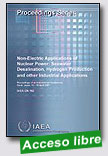 |
Non-electric Applications of Nuclear Power: Seawater Desalination, Hydrogen Production and other Industrial Applications
IAEA Proceedings Series, 2009, 56 p.
This is the proceedings of an international conference on non-electric applications of nuclear power. Participants at the conference addressed nuclear energy’s current role in the global energy supply and, given its environmental and strategic benefits as a sustainable resource, considered how best to expand its use to meet a greater proportion of the world’s energy demands. The proceedings also present discussions on the |
importance and challenges of extending nuclear power to developing countries around the world. The publication contains the text of all contributed papers, summaries of the sessions and the panel discussions. The accompanying CD contains the poster presentations.
Extraído de:
http://www-pub.iaea.org/MTCD/publications/PubDetails.asp?pubId=7979
|
 |
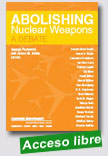 |
Abolishing Nuclear Weapons: A Debate
Carnegie Endowment for International Peace, 2009, 344 p.
The pathbreaking paper Abolishing Nuclear Weapons by George Perkovich and James Acton was first published by the International Institute for Strategic Studies as an Adelphi Paper in September 2008. One of the paper’s major aims was to prompt serious international analysis, discussion, and debate, recognizing divergent views within and between nuclear-armed states and those that do not possess these weapons. The absence of such engagement in official forums such as Non-Proliferation Treaty Review Conferences and the Conference on Disarmament makes it vital for nongovernmental actors to take the lead in hopes that governments will see the value of such dialogue and follow. The present volume takes the next step. To advance the sort of analysis and dialogue Perkovich and Acton call for, they have invited a distinguished group of experts—current and former officials, respected defense analysts—from thirteen countries, nuclear and non-nuclear, to critique the Adelphi Paper. Their diverse views explore pathways around obstacles to nuclear disarmament and sharpen questions requiring further official and nongovernmental deliberation. Perkovich and Acton are grateful to the contributors for the thoroughly constructive character of their critiques. |
|
 |
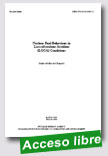 |
|
Extraído de:
http://www.nea.fr/html/pub/ret.cgi?id=new#6846
|
 |
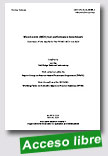 |
Mixed-oxide (MOX) Fuel Performance Benchmark (PRIMO)Nuclear Energy Agency (NEA), 13-Jul-09, 40 p.
The plutonium produced during the operation of commercial nuclear power plants or that has become available from the dismantlement of nuclear weapons needs to be properly managed. One important contribution to the management process consists in validating the calculation methods and nuclear data used for estimates concerning power systems burning mixed-oxide (MOX) fuel. Another important contribution is the improved modelling of MOX fuel behaviour in such systems. |
Within the framework of the NEA Expert Group on Reactor-based Plutonium Disposition, a fuel modelling code benchmark test was carried out for MOX fuel, with irradiation data on the BD8 MOX rod of the PRIMO programme provided by SCK CEN and Belgonucléaire. This report summarises the data provided and the fuel characteristics for the irradiation, and presents the calculation results provided by the contributors.
Extraído de:
http://www.nea.fr/html/pub/ret.cgi?id=new#6291 |
 |
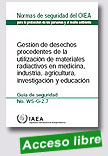 |
Gestión de desechos procedentes de la utilización de materiales radiactivos en medicina, industria, agricultura, investigación y educación
IAEA Colección de normas de seguridad, 2009, 81 p.
This Safety Guide provides recommendations and guidance on the fulfilment of the safety requirements on management of radioactive waste. It covers the roles and responsibilities of different bodies involved in the predisposal management of radioactive waste and in the handling and processing of radioactive material. It is intended for organizations generating and handling radioactive waste or handling such waste on a |
centralized basis, and for the regulatory body responsible for regulating such activities.
Contents: 1. Introduction; 2. Protection of human health and the environment; 3. Roles and responsibilities; 4. General safety considerations; 5. Predisposal management of radioactive waste; 6. Acceptance of radioactive waste in disposal facilities; 7. Record keeping and reporting; 8. Management systems; Appendix I: Typical radiation sources used in medicine, industry, agriculture, research and education and the associated radioactive waste; Appendix II:Fault schedule for safety assessments and environmental impact assessments; Appendix III: Flow diagram for the management of solid radioactive waste; Appendix IV: Flow diagram for the management of biological radioactive waste; Appendix V: Flow diagram for the management of disused sealed radiation sources; Appendix VI: Disused and spent radiation sources and identification of techniques for their management; Appendix VII: Strategy for the identification and location of spent and/or disused sealed radiation sources.
Extraído de:
http://www-pub.iaea.org/MTCD/publications/PubDetails.asp?pubId=7365
|
 |
 |
Nuclear Energy in the 21st Century: Addressing Energy Needs and Environmental Challenges
IAEA Proceedings Series, 2009, 80 p.
The International Ministerial Conference on Nuclear Energy in the 21st Century provided an opportunity to review the status and prospects of nuclear power, and to discuss the actions necessary to carry forward the positive momentum that nuclear power has experienced in recent years. It also offered a forum for countries considering the potential benefits of introducing nuclear power into their national energy mix to further assess the viability of the nuclear power option. Conference participants
|
discussed developments and emerging issues relevant to the role of nuclear power in providing clear and sustainable energy for national and regional development. The technical sessions were devoted to energy resources and the environment; available technology and long term perspectives; infrastructure development and safety and legal issues; and reliable fuel supply, spent fuel, waste management and strengthening of non-proliferation.
Extraído de:
http://www-pub.iaea.org/MTCD/publications/PubDetails.asp?pubId=8255
|
 |
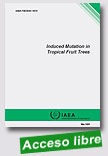 |
Induced Mutation in Tropical Fruit Trees
IAEA Tecdoc Series, 2009, 170 p.
Despite the tremendous efforts devoted to fighting poverty and ensuring food security for all, humankind still faces a serious challenge. This situation is currently exacerbated by the huge increase in food prices along with a significant decrease in food crop productivity in many developing countries. The ultimate challenge now is to understand that alleviation of poverty
in the world requires efforts from all the parties involved: governments, international organizations, scientists, breeders |
and farmers, and should also include concerns about climate change and variability.
Over the past 40 years, the Agency, through the Joint FAO/IAEA Division of Nuclear Techniques in Food and Agriculture, has assisted Member States in increasing food crop productivity and enhancing the livelihood of people around the world. Many success stories can be found in Asia, Africa and Latin America, as well as in developed countries including Europe, Japan and the USA. This continuing effort is supported by scientists who, under the Agency’s coordinated research projects (CRPs), work to expand knowledge of the mechanisms and the benefits of induced mutagenesis together with efficiency enhancing bio/molecular technologies such as in vitro and molecular characterization techniques. This book reports on the results obtained in inducing mutations in selected fruit trees, important for human dietary needs and a healthy lifestyle. Fourteen countries participated in the CRP entitled “Improvement of Tropical and Subtropical Fruit Trees through Induced Mutations and Biotechnology”. The original and most advanced results are presented here with the hope that this publication will assist scientists using induced mutation to improve fruit trees.
Extraído de:
http://www-pub.iaea.org/MTCD/publications/PDF/te_1615_web.pdf
|
 |
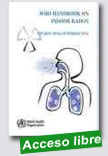 |
WHO handbook on indoor radon: a public health perspective
World Health Organization (WHO), 2009, 110 p.
The WHO handbook on indoor radon is a key product of the WHO International Radon Project, which as launched in 2005. The handbook book focuses on residential radon exposure from a public health point of view and provides detailed recommendations on reducing health risks from radon and sound policy options for preventing and mitigating radon exposure.
The material in the handbook reflects the epidemiological evidence that indoor radon exposure is responsible for a |
Isubstantial number of lung cancers in the general population.
The material is organized into six chapters, each introduced by key messages. Usually, technical terms are defined the first time they are used, and a glossary is also included. Information is provided on the selection of devices to measure radon levels and on procedures for the reliable measurement of these levels. Discussed also are control options for radon in new dwellings, radon reduction in existing dwellings as well as assessment of the costs and benefits of different radon prevention and remedial actions. Also covered are radon risk communication strategies and organization of national radon programmes.
This publication is intended for countries planning to develop their national radon programmes or extend such activities, as well as for stakeholders involved in radon control such as the construction industry and building professionals.
The overall goal of this handbook is to provide an up-to-date overview of the major aspects of radon and health. It does not aim to replace existing radiation protection standards, rather it emphasizes issues relevant to the comprehensive planning, implementation and evaluation of national radon programmes.
Extraído de:
http://apps.who.int/bookorders/anglais/detart1.jsp?
sesslan=1&codlan=1&codcol=15&codcch=763 |
 |
|
|
|
|
| |
|
|
|
|
|
